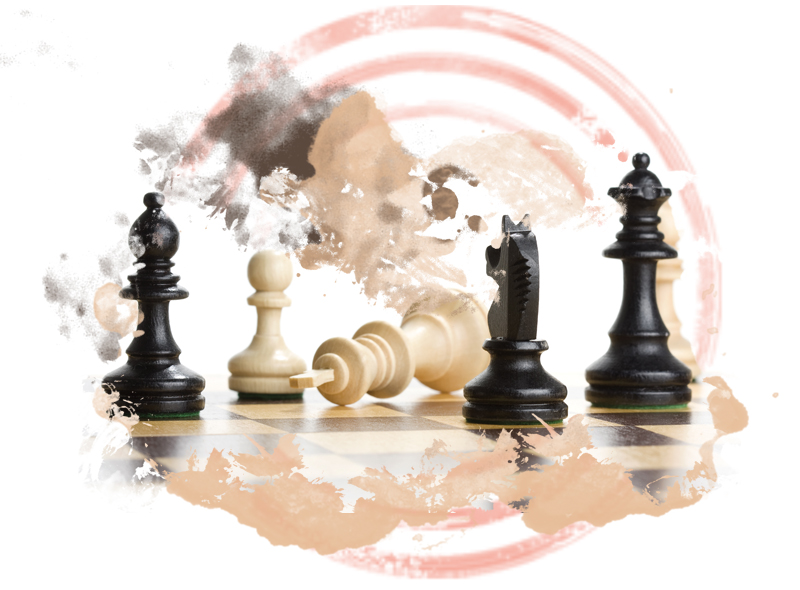64 black and white squares… 32 pieces… Both a game, a science and an art. Both ancient and contemporary. An order set up each time. A giant structure although there are no foundations… An imaginary realm opening to eternity despite appearing mechanical… Chess!
Infinite combinations on a finite field. This is exactly why it is fascinating… Neverending motion on stability. A mental parade in which moves follow one another when mind is focused on a single thing. If chess is an art, the artwork is a brilliant mind. If it is a science, a one-time combination of contrasts… It belongs to people of all ages, even all people… Its player is a sense sharpener skilled in moving 32 pieces back and forth and sideways….
There are countless rumors regarding the origin of chess. The word “Satranç” (chess in Turkish), “çet-reng” in Farsi and later “satranc” in Arabic, is derived from Sanskrit “çatur-anga” (four divisions). Four divisions are thought to be infantry, cavalry, elephants and chariotry. Chess is widely believed to have originated in India. There is a rumor surrounding its invention in historical documents: Inventor of chess was a wise man from India and he presented the Shah with chess. Enchanted by the game, Shah told the wise man to make his wish. Wise man asks double the wheat he won in the previous square for each square on the board. Although Shah deprecated the idea at first, the amount calculated at the end yaequaled to the amount of wheat produced in 1500 years.
Chess was primarily invented to teach the essence of art of leadership properly to those who would rule in the future. Teach them the war tactics. And it became widespread as the game of kings, scholars and pundits.
TRACES ON TURKISH CULTURE
Chess spread to the world from India, became popular among Persians, later among Arabs in the 7th century, and eventually arrived in Europe through Andalusia. Iran is considered a major stop in the history of chess. It became popular in Arab society after Omar. Although Islam scholars held different opinions regarding chess, it was allowed as long as it did not involve gambling, and not cause one to neglect fundamental duties or duties to God, family and the society. Moreover, its benefits were reminded because it strengthens the mind, develops character, improves selfconfidence and enables socialization. Chess popularized in Turkish Islamic societies, entered Turkish, Farsi and Arabic literatures as well. Its etiquette took shape in a refined literary language. Rules formalizing chess were established in addition to books written independently as ‘Edebü’ş-satranç’ (Etiquette of Chess). Author urged the players to pay extra attention while playing in the presence of Khalifa and high officials. Cahiz mentions that a good nedim (Sultan’s friend) must be as skillful in chess as in archery and hunting. It is known that in memorial ceremonies of Seljuk Atabeg Muzafferuddin Gökböri, chess games would be organized alongside music performances.Evliya Çelebi narrates that communities of mosques in some Ottoman cities would play chess, and he even witnessed a fight broke out in a mosque in Bitlis during a game.
As chess became popular among Persians and Arabs, it entered the Byzantine Palace. However chess was brought to Europe by Andalusian Umayyads through Andalusia. Meanwhile many faced excommunication after the 11th century because Church regarded chess an element of Islamic culture. And chess went through some changes. In the 15th year, queen replaced vizier, priest replaced elephant, and knights replaced cavalry, and this game system prevailed. It was transformed to integrate in European culture. Christopher Columbus is known to bring his chess set to long cruises. Pascal describes chessboard as a gym for human mind. It is defined as a psychological battle between two minds. Although a chess board, pieces and two players are required as chess is a game based on combat, the spectacular literary narrative in the novella ‘A Chess Story’ by Stefan Zweig manifests the emotions when one plays chess solo. Zweig expresses how one competes against one’s self both as black and white players as follows: “As black, I would impatiently wait for white’s next move which I would also be making. Both players in me would be glad when the other made a mistake and concurrently felt sorry for their own inaptitude. This was such an experience that an absurd situation emerged where the brain was both aware and unaware of things. It is as paradoxical, as attempting to jump over his own shadow.” But of course as Zweig said, the real charm of chess is in two different brains developing strategies.
WOMAN AND CHESS
Although there is no special mention of “women and chess” in historical documents, there are rumors of female presence in this strategy game. Rumor has it, Abbasid Caliph Harun al-Rashid lost three consecutive games to a female slave, and the woman wished for freedom of someone of great value for her. Another Caliph, Memun is thought to refer to a female slave as follows: “I have never met another woman with such beauty, such humor, such eloquence and quick-wit, this good at chess and backgammon”. A prominent Islam historian Maverdi who took pride in his chess skills is said to have won a chess game against a scholar with help from a female slave.
On the other hand, Islamic history sources suggest that Madinah locals did not allow their daughters to marry men who played chess for “chess is like a second wife”. However it has always been common where women divorce their husbands claiming they are too occupied with chess to take care of something else. The most popular historical story about chess is undoubtedly the chess game between Selim I and Shah Ismail. Rumor has it when Yavuz was still a prince in Trabzon, he visited Tabriz in disguise. He played against Shah who was a good chess player, and won. Although this rumor is not historically accurate, it may be representing the epic aspect of Yavuz’s Iran policies which echoed among people. Throughout the history, chess has not been just a game and took its part in all spheres of life from military reports to poetry, from calligraphy to holy night celebrations, and even in textiles. It appears that chess dating back to 4 thousand B.C. with first records in Egyptian Pyramids, will continue to live as a science and an art and will never be out of fashion as long as humanity exists.









Leave a Comment